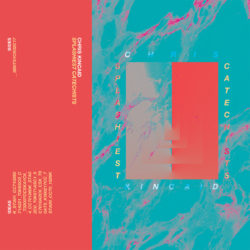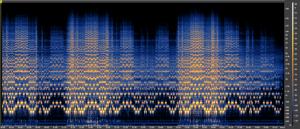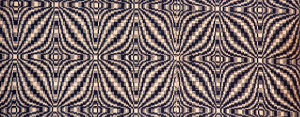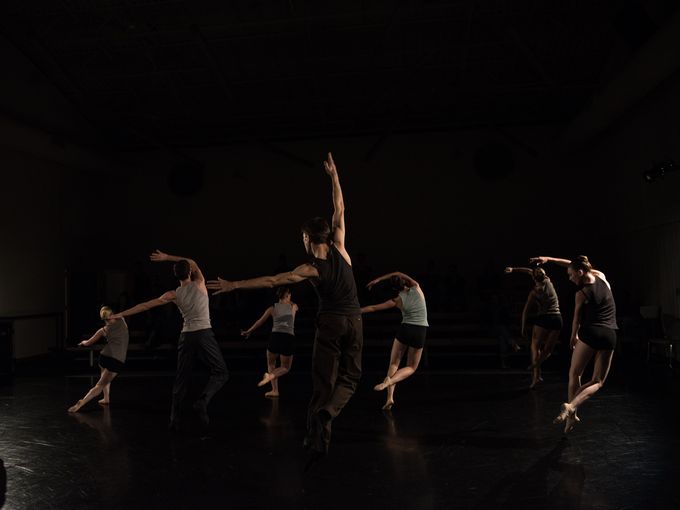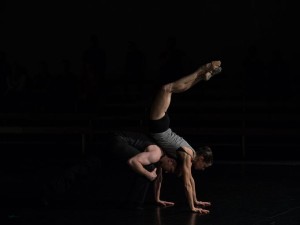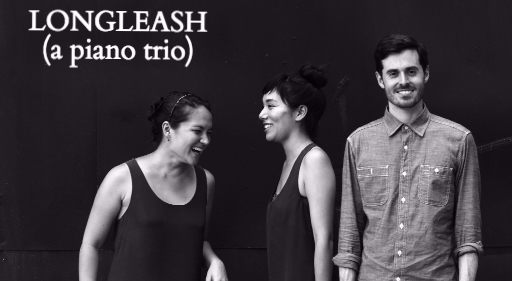Check out my review of 8Dio’s new orchestral sample instrument bundle, Century Strings Bundle over at Audio News Room. I talk about how it fares compared to other sample instruments as well as my love for Downton Abbey and Elliott Carter!
Splashiest Catechist Review
Check out Never Nervous’s words about my sounds!
Ableton Push + Laptop Case (A long time coming)
I love to tinker and I probably spend as much time thinking about interfacing with and transporting gear as I do practicing on said gear. Because of that I’m always building new cases for whatever setup I’m performing with.
Years ago it started with a 24U – 19″ rack on casters with a bunch of extra crap on top that my band mates lovingly dubbed, “the go-bot” because of how tall it was and how it resembled a corny 1960s robot. It included a full desktop running reason, a touch screen monitor (the old shitty ones that didn’t really work very well) rack mount delay, 2 tube heads, a Hohner pianet-t, and an 88 key midi controller. It was overkill but 22-year old me was dumb and fine with lugging it to shows. It weighed about 120 pounds.

The next iteration was dubbed by the same band mates as, “the child coffin” due to it’s dimensions (roughly 4’x2’x1.5′) and because it took at least 2 people to carry it anywhere. It had the 88 key controller, a duo core white macbook, a rack mount tube amp, and a couple of those korg nano controllers mapped to Ableton. It weighed about 60 pounds. Unfortunately I can’t find a picture of this one.
After years of playing with heavy gear I began obsessing about a light setup. I found an old bass guitar case, replaced the hinges with the breakaway kind, and filled it with smaller midi controllers, an audio interface, and a laptop. This was the first setup I could load in by myself and I loved it! At the same time I went off the deep end with Ableton macros and dummy clips (and my label maker apparently.) 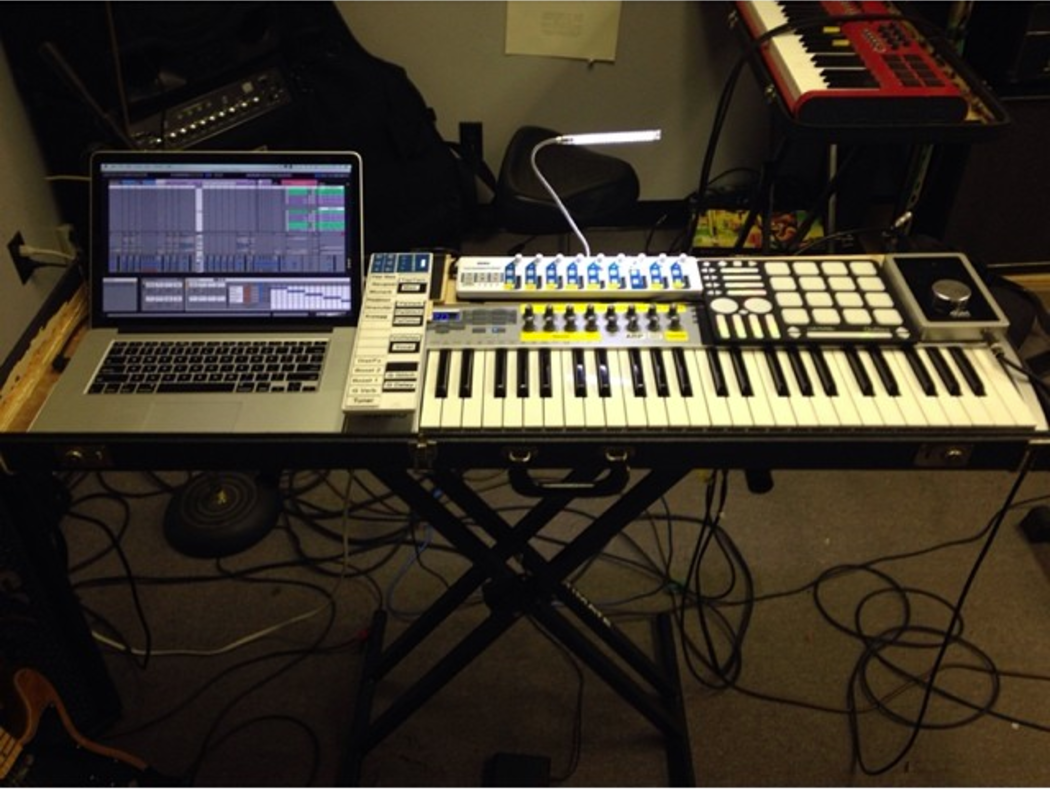
Then came the Ableton Push controller. I was smitten with this thing because of how well they seemed to streamline everything into 9 knobs and a bunch of buttons. Below is the first iteration of my live setup with Push. It was all housed in a cheap but giant guitar foot pedal case. I had a usb hub connected to the Push, the audio interface, a usb foot pedal, a midi out to send clock to the guy beside me, and a DMX device that sent data to leds from the Ableton Live set. This case worked alright but there was too much space in the top of the case so things would float around inside the case during transport. 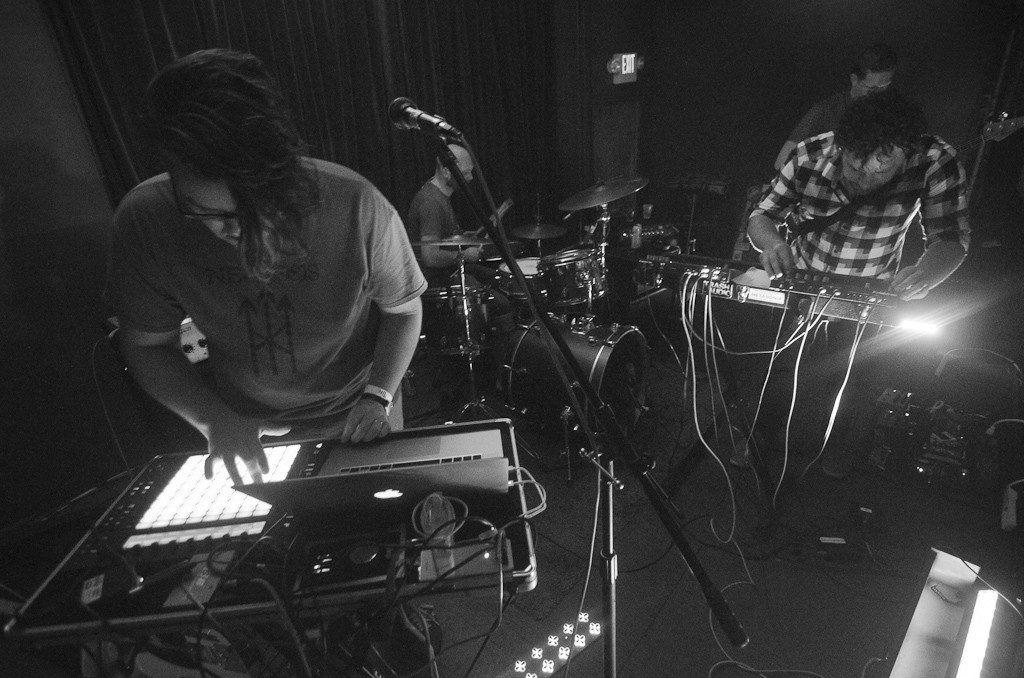
I thought about the most recent iteration for about a year before building it. I wanted the form factor of the last one with even less space for things to move. I wanted something that I could take the top off, plug in, and start playing. This is what I came up with: 
It’s about as streamlined as possible since it is purpose built for the Push and my laptop. I used big box “furniture quality pine” that was fairly straight and sturdy enough. I wanted this case to protect my laptop, a device I use for 100% of all the work I do for money. I couldn’t risk it being damaged at a show. This case delivers on that part too. I could probably stand on it when the lid is on and my laptop would be as happy as a clam protected under 3/4″ of wood. Underneath the laptop is a pull out shelf hiding the audio interface, power, usb hub, and DI box to send balanced signals to the house PA.

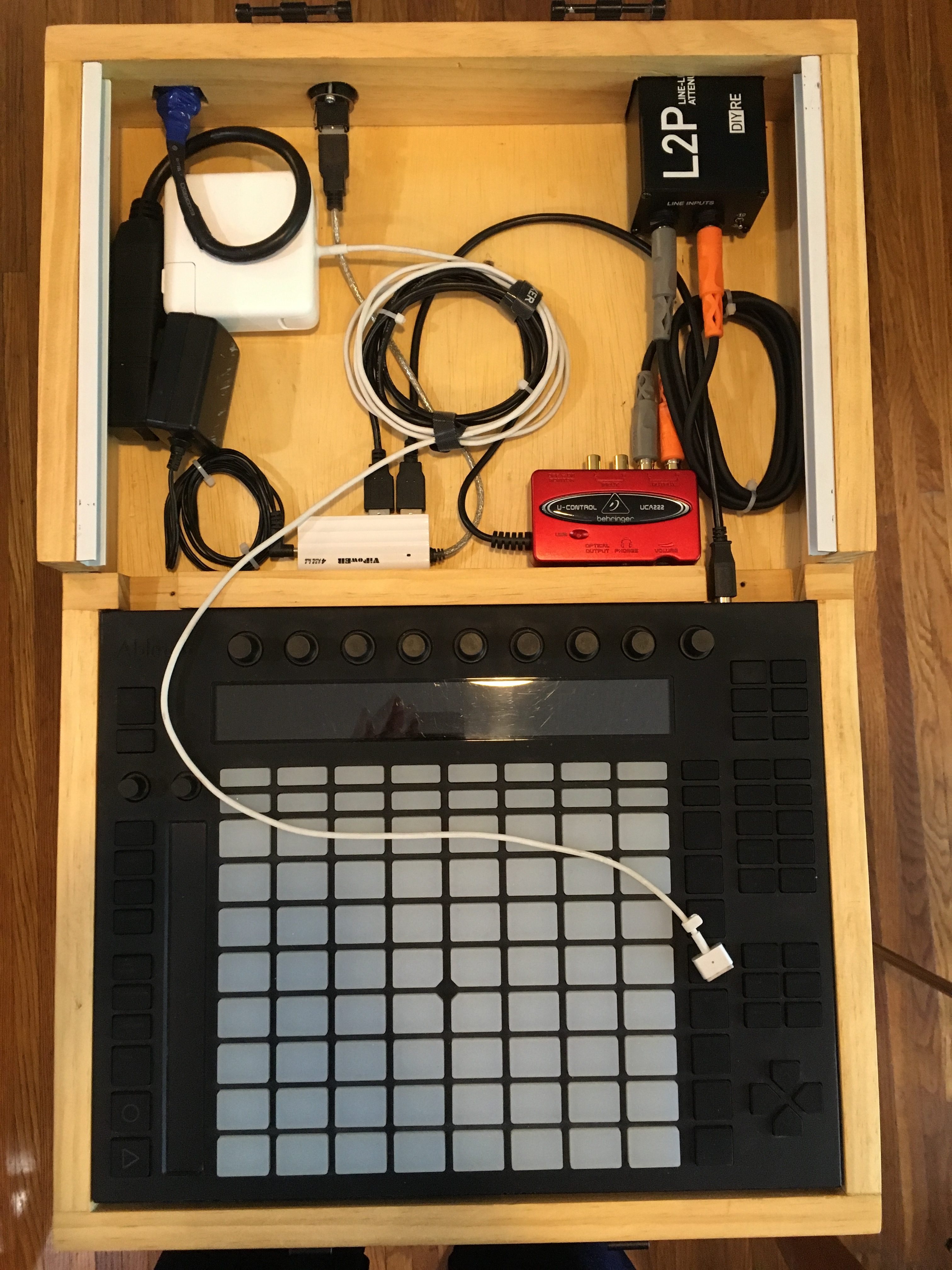
A closer look at the somewhat tidy wiring.

I had some scrap wall shelf mounts (the white metal strips) that worked perfectly for a drawer slider.

I hardwired the power cord to an IEC jack on the back and cut out holes for a usb port and the DI. This way when I’m playing a show and when I have to break down for the next band/artist it takes almost no time to disconnect everything and set it off stage. 
I’m pretty happy with this new case but I can tell I’m already wanting to get the newer Push 2. My day job is teaching applied music technology at a university and I feel like I should be familiar with everything the current controller offers. Also it will give me an opportunity to make another one of these cases and this time teach myself to make box joints and mortices so I can do it without having to fill in any screw holes with wood filler! 🙂 On to the next case!




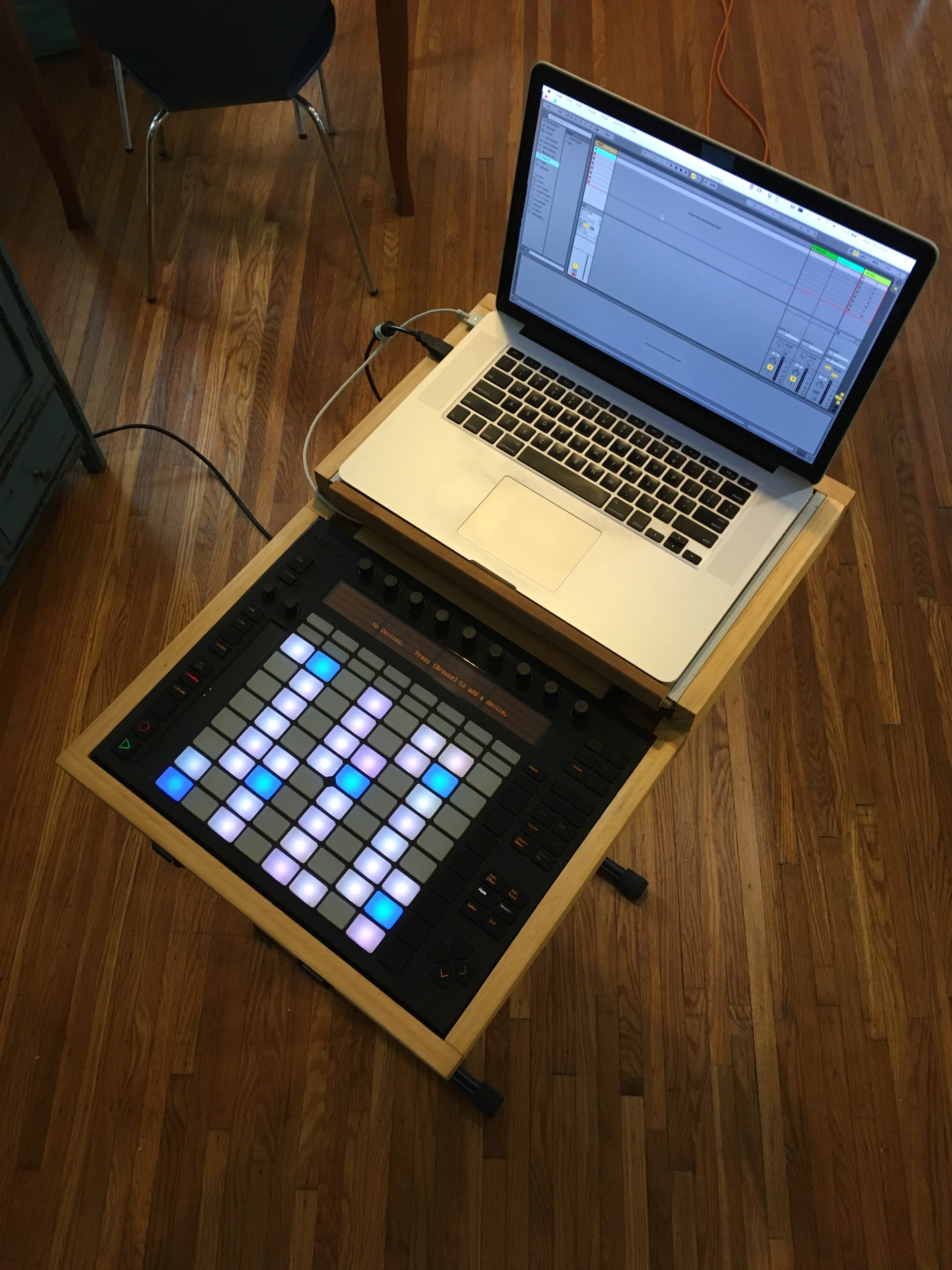


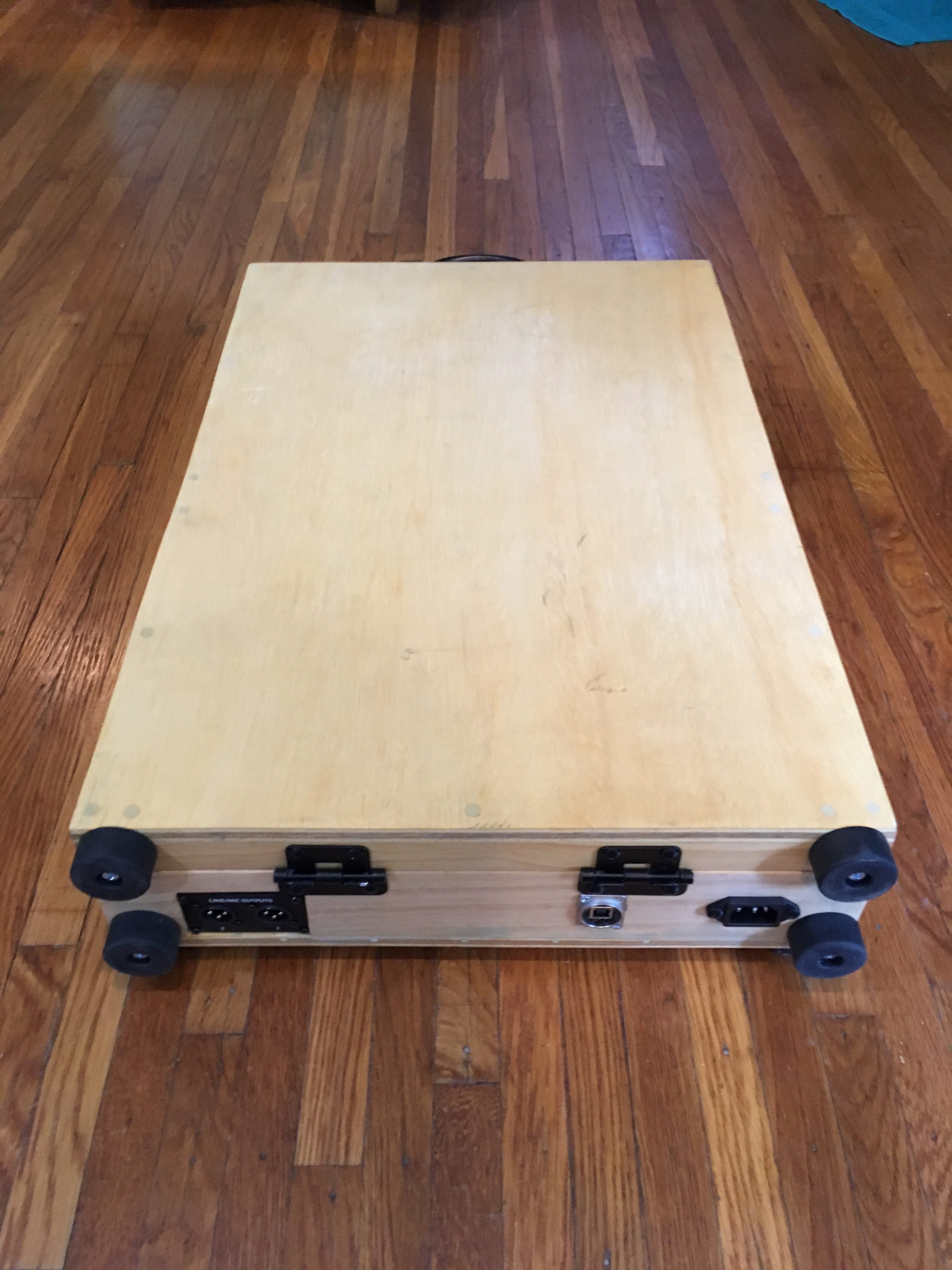
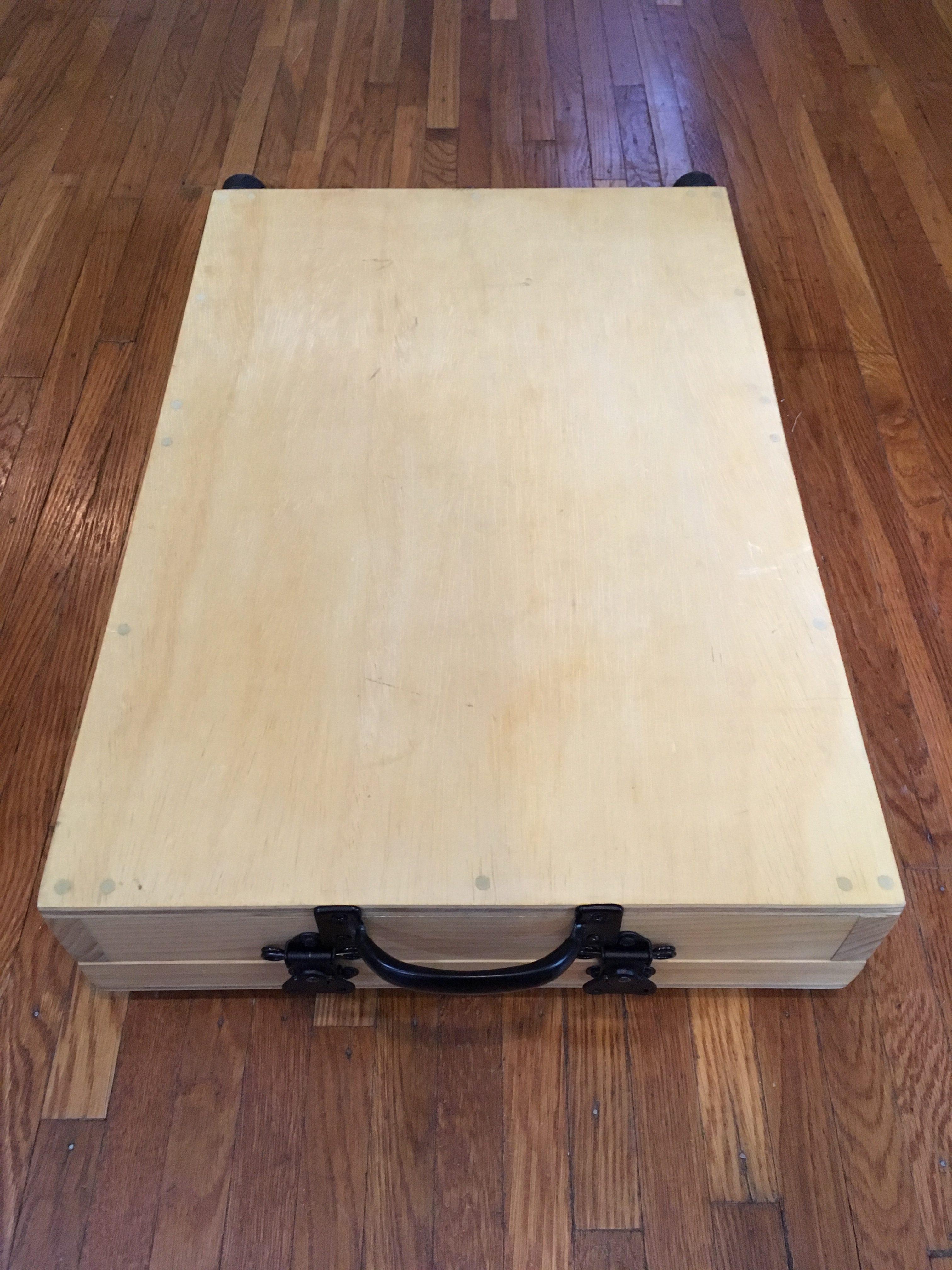
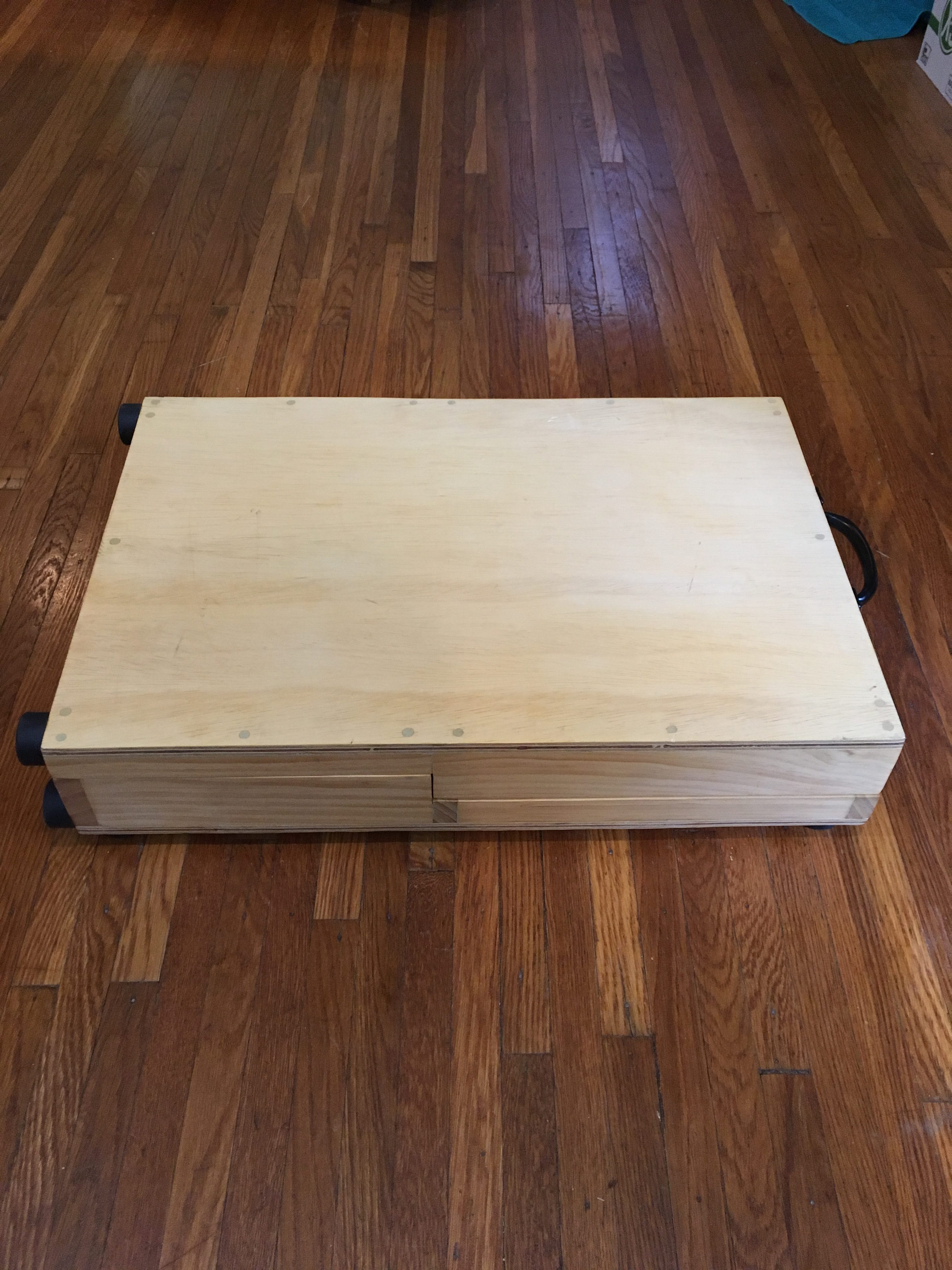
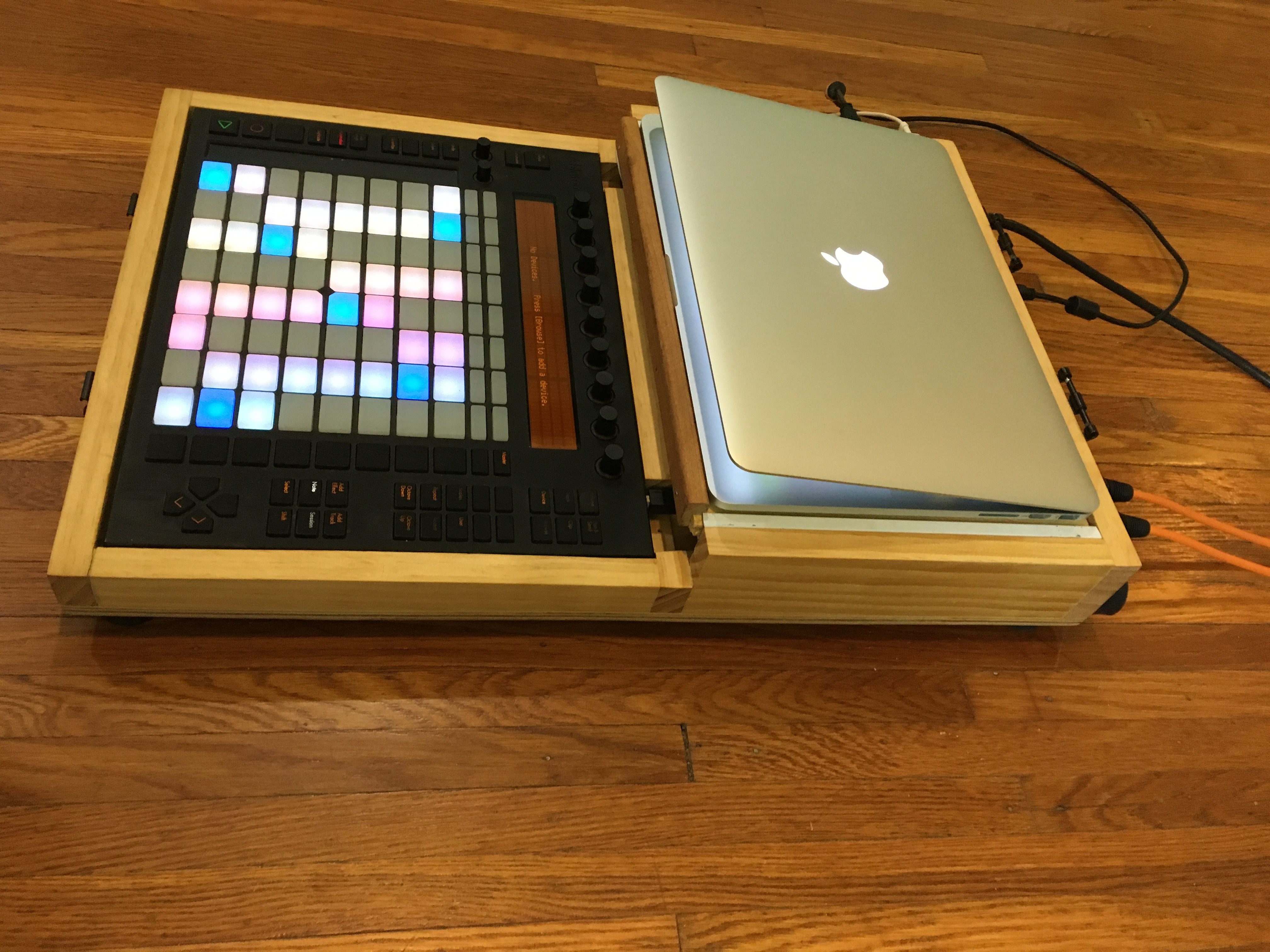

A Year In Review
As so many other personal/professional websites mine has been neglected for over the past year. It has been a busy year filled with new experiences, opportunities, struggles, and slowly creeping gray hairs. Instead of creating individual posts I’ll distill it all into one post here:
March: Published an article on the perils and excitement of modular synthesizers at Audio News Room. Recorded lots of high school orchestras and a couple of rock bands.
April: Completed a large music arrangement job. Consulted at a local university on how to promote the composition department and increase interest of prospective students. Performed as a member of the ensemble of a GPS piece by Marek Choloniewski.
May: More orchestral and band recordings. Drove to Charleston, S.C. to see a rare performance of Helmut Lachenmann’s Little Match Girl, an opera that I’m still blown away by! I also revised and recorded my first string quartet, Overshot. Played a show with my band, Karass
June: My string quartet, Overshot opened as an installation piece at the Center for Craft, Creativity, and Design in Asheville N.C. Recorded and mixed a song cycle for friend and composer, Daniel Gilliam.
July: Played another show with my band, Karass. Traveled to Michigan for a friends wedding and all the beautiful craft brews in that state. Traveled to Asheville to give a presentation on my string quartet, Overshot and it’s connection to weaving traditions of Appalachia with my wife, Leslie Clements.
August: Recorded the concerts for the Loretto Festival, a new music festival here in Kentucky presented by Longleash piano trio. I played the final show with my band, Karass. We had played together for about 8 years. August was an especially exciting month because I began teaching applied music technology at the Music & Arts Technology program at Indiana University Purdue University Indianapolis.
September, October, November, & December: I focused most of that time building my curriculum for class, grading, and basically getting acclimated to teaching almost full time. Outside of the new gig I recorded several high school orchestra concerts, began to mix a series of large professional orchestral concerts, and performed a solo modular set at Dreamland in Louisville. In this time I also wrote a piece, Retro for IUPUI’s acoustic electric ensemble and finished my first solo electronic album, Splashiest Catechists for Louisville label City State Tapes. It will come out in July 2017.
January: I began my second semester teaching music technology at IUPUI, this time with an expanded teaching load. I also flew out to Anaheim, CA for the 2016 NAMM show. That was a weird weekend.
February: I got laZZZers shot into my eyes so I could throw away the glasses I’ve worn for the past 17 years! Yay!!!!
March: I recorded about 150 high school orchestras, choirs, and bands. Later in the month I drove down to Knoxville, TN to see the Big Ears new music festival. I’m not normally one for music festivals but Big Ears and Knoxville do it right! Great music, interesting lectures, and tons of great beer and food to choose from.
April: I gave a sponsored presentation to IUPUI students on an introduction to subtractive synthesis with a modular synthesizer. Performed a beautiful piece, Fugue in 13 stages by friend and composer Rob Collier.
May: School’s out! Worked on some home projects I’ve put off for years like landscaping. Finished up the last couple of high school orchestra recording gigs for the spring season.
June: I’ve been working on several freelance projects including a new work by visual artist and composer, Paul Lorenz and a VR mixing project that I will post more about soon!
That about catches us up. Hopefully I’ll be a bit more proactive on here in the near future. Fingers crossed!
East Point Film Score
I stayed busy in December writing roughly forty minutes of music for the post-apocalyptic zombie film, East Point. The score is driven primarily by modular synthesizers, cello, piano, and a few orchestral cues. Check out some of the cues here:
I also mixed the sound for both the 5.1 theatrical release and the stereo DVD release (out soon!)
Overshot (for strings and electronics): The Kentucky Coverlet Connection Exhibit
This weekend at the Doris Ullmann gallery on the Campus of Berea College a collaborative exhibit opened between myself and Louisville’s historical fiber arts nonprofit organization, the Little Loomhouse. The exhibit titled The Kentucky Coverlet Connection: Lou Tate, the Little Loomhouse, and Berea displayed the world-class collection of woven Kentucky coverlets, weaving draft patterns, and historical artifacts that tell the story of this folk art tradition and Lou Tate’s legacy as a weaver and historian, including her time as a student at Berea College. My contribution was an installation of my newest work,”Overshot”, six movements for strings and electronics, influenced by typical Kentucky folk weaving patterns.
Listen to it here: Overshot (for strings and Electronics)
Program: Overshot Program by Chris Kincaid
Overshot
for strings and electronics
The music you are hearing is inspired by historic Kentucky coverlets, the weaving technique known as “overshot,” and several popular patterns of weaving drafts, which Lou Tate often remarked resembled a musical staff. The woven coverlet, a staple of Appalachian folk art, was usually created in the home and has a strong identity with patterns that emerged and evolved over time, through the sharing of drafts between generations of weavers eager to create something new.
Overshot utilizes the instruments found in a string quartet, especially the cello, as well as electronics to create six movements inspired by various aspects of this rich textile art. Each movement focuses on a different aspect of weaving, such as: literal translations of draft patterns; ideas elicited in the names of popular drafts; the nature of weaving’s oral pedagogy; aural approximations of the visual contour in finished patterns; and the meditative and rhythmic action in the physical act of weaving. The musical form of Overshot is a nod to one of Beethoven’s last string quartets, op. 130, No. 13 in Bb major.
I. Whig Rose – Adagio, ma non troppo (Slow, but not too slow)
This movement translates an overshot pattern into musical notation in a very literal sense. The markings on the draft correspond to a space in between the bar lines of the music. The interest comes from interpreting this same pattern for several different instrument clefs at different rates of speed, creating an algorithmic lattice from the simple four note pattern.
II. Chariot Wheel – Presto (Fast)
This movement elicits the idea of unwieldy motion, speeding forward. Like a chariot wheel spinning furiously, the descending theme rushes toward the end.
III. Cat Tracks and Snail Trails – Andante con moto, ma non troppo. Poco scherzoso (Moderately slow, with motion walking, a little playful)
Although there have been many great books published on weaving, there has always been and continues to be a strong tradition of learning to weave through oral communication. In this movement, the voices of instructors from videos found on Youtube are transcribed and juxtaposed against each other in the voices of four cellos. The cacophony feels similar to my own experiences I had when I first started to learn about weaving. The variety of terminology and approaches of many Youtube instructors was interesting while simultaneously perplexing. After a while it begins to make sense.
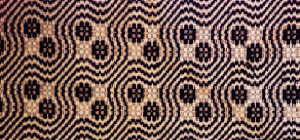
IV. Pinetree – Alla danza tedesca. Allegro assai (German dance, very fast)
This movement focuses on a singular sound expanding and contracting, mimicking the visual contour of a pine tree design. The motion in this movement related to the tempo markings is not present throughout, but instead found in the moments of expansion.
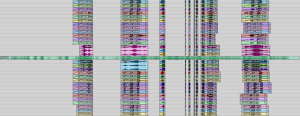
V. Snowball – Cavatina. Adagio molto espressivo (Short song of simple character, slowly with expressiveness)
Watching a person that is weaving can be a meditative experience. Soon you begin to hear a rhythm that feels very natural. In this movement, the recorded sounds of a working loom are captured. They bring with them a calm similar to the quiet period after a snow fall.
VI. Double Bowknot – Fugue
A fugue is a technique for several voices where a theme is presented in a variety of ways. It can also describe a form of mental state that includes confusion and hysteria. This final movement of Overshot uses ideas from all of the previous movements and juxtaposes them against each other, creating a chaotic state. The appearance of the double bowknot distorts the viewer’s perception of depth. The shapes give the illusion of bulging in the coverlet. The result is hypnotic.
Performing with the Louisville Ballet
Last week I had the opportunity to perform with the Louisville Ballet for their annual Choreographer’s Showcase. Composer, Tim Barnes asked me to join the ensemble for his piece comprised of cicada/bird field recordings, electronics, horn, guitar, violin, and percussion. All four performances sold out early and were met with an engaged audience. Tim’s music was paired beautifully with Andrea Schermoly’s choreopgraphy . Also on the concert were fantastic works by composer/choreographer collaborations Daniel Gilliam/Ashley Thursby, Ben Sollee/Brandon Ragland, and Kyle James Hauser/Eduard Forehand. I especially loved the variety in music and choreography styles throughout the night. Check out some of the reviews below and pictures by the staff of the Courier Journal.
http://www.courier-journal.com/story/entertainment/arts/dance/2015/11/05/review-ballets-showcase-mark-maturity/75174466/
New Music, Dance Pairings An Exciting Twist For Louisville Ballet’s ‘Showcase’
New Commission, Album Mastering, Guest Lecturing, & Upcoming Gallery Installation
September is almost over and it flew by!
The video game I worked on last month, Treatment and Control for the Ludum Dare 33 was voted #41 out of 1500+ entries in the audio (music and sound design, which I did both) and #13 in mood (which the sound definitely contributed to.) The team at Two Scoop Games was great to work with!
My friend and talented clarinetist, Samantha Holman has commissioned a new work from me for bass clarinet. I am beyond excited to start working on this piece!
Another good friend, Tim Barnes reached out to me to master a live recording of a collaboration of himself and Jeff Jerman. It is a fantastic recording and I can’t wait to see the release! Tim is a brilliant musician working especially in electronics and percussion, curator of sound with his Quakebasket Records, as well as running Louisville’s hub of everything aurally strange and beautiful, dREAMLAND.
I am completing the final few notes in a composition that will partner with the Little Loomhouse, a fiber arts and historical preservation community here in Louisville for a gallery showing in Berea, Kentucky next month. My piece, Overshot was originally a planned as a string quartet but has shifted to part string quartet, part field recordings and strings. The inspiration of the work comes from the procedures and outcomes of the overshot technique of weaving a coverlet. More to come on the opening later this week!
This afternoon I will be guest lecturing in the Advanced Digital Techniques class at the University of Louisville. The class focuses on working in the Max/MSP and Protools environments. My presentation will focus on integrating Max/MSP into Ableton Live, another popular DAW and it’s potential in the applications of composition and live performance.
Music for Games
I met Alex and Eric from Two Scoop Games a few months ago and they asked me to join their team for Ludum Dare 33, a 48-hour game festival much like the 48-hour film festivals. Instead of making a movie you make a game from scratch based on a theme that is released at the start of the event. This year’s theme was , “You are the monster.” It was a personal goal of Eric and Alex to create a game that did not focus on humor because so many of their games in the past have. This one, Treatment and Control is all about working in a role where you don’t quite understand the impact of your job. As the game progresses the player begins to understand what their role is, and it isn’t pretty.
I created the music and sound design (footsteps, talking sounds, menu popups) over the weekend using my cello, some piano, field recordings made on site at the event space, and tons of post synthesis. It was a blast!
Hear the music and play the game here.
New Commission and Contemporary Music Festival
I have been invited to participate in the Loretto Project, a new contemporary music festival here in Kentucky by the New York piano trio, LONGLEASH. They created a kickstarter to alleviate some of the costs of transportation, housing, and meals for the composers and performers, as well as the free concert series that is open to the public. Below is a little more about the festival:
The Loretto Project
The Loretto Project (August 11-15) is a celebration of adventurous new music at the Loretto Motherhouse in Nerinx, KY. The project includes a composition seminar led by Composer-In-Residence NILS VIGELAND, a public masterclass with MARC SATTERWHITE, 3 public performances, and a composition commission. Longleash (piano trio) will serve as project leaders and ensemble-in-residence. Inspired by the rich history of American contemporary music – music with deep roots in Kentucky and beyond — we are very excited to explore this tradition at Loretto, and in doing so, help establish an artistic dialogue across state lines, generations, and creative communities.
JOIN THE LORETTO PROJECT KICKSTARTER!
Our creative goals:
- to establish an annual musical exchange between our Kentucky and New York based audiences, and to reach new listeners in both communities
- to share diverse and exciting contemporary music with these audiences by supporting the work of NY and KY based working composers and the next generation of student composers
- to provide a meaningful cultural service to the central Kentucky region through high-quality, adventurous, and thoughtful programming
About the Motherhouse Facilities: Founded in the early 1800′s, the Loretto Motherhouse is the spiritual center of the Sisters of Loretto. It is located in central Kentucky, about an hour drive from Louisville. The Motherhouse includes a working farm, beautiful brick buildings, and an operational retreat center. Students and Artist Residents will be housed in the Academy building, and all activities and meals will take place on the grounds.
A video of the LONGLEASH trio performing Phantasmagoria by Bent Sørensen

